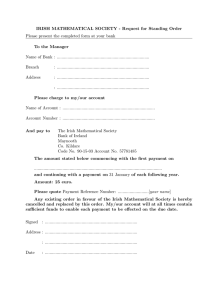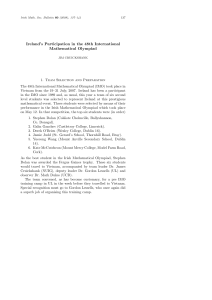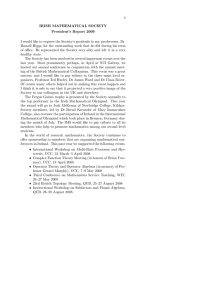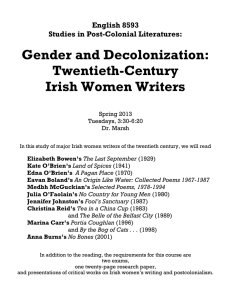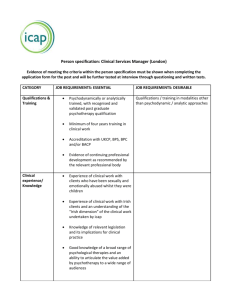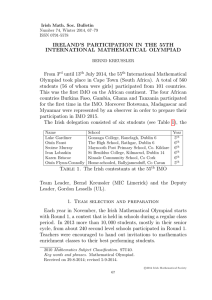IRELAND’S PARTICIPATION IN THE 54TH INTERNATIONAL MATHEMATICAL OLYMPIAD From 18 to 28
advertisement
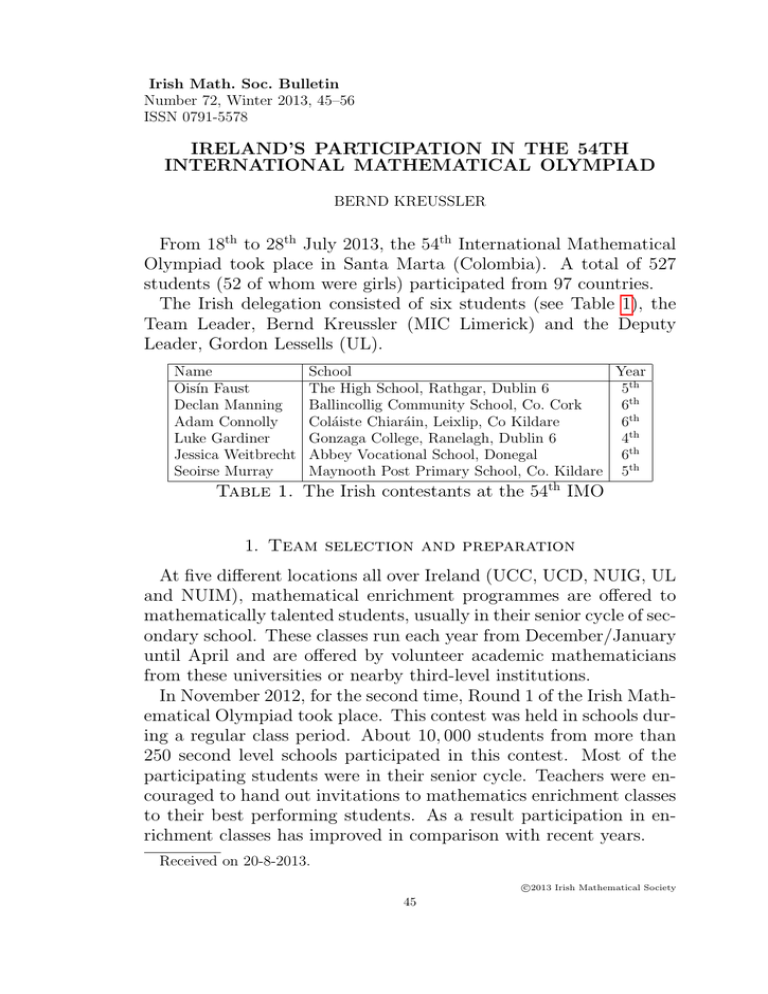
Irish Math. Soc. Bulletin Number 72, Winter 2013, 45–56 ISSN 0791-5578 IRELAND’S PARTICIPATION IN THE 54TH INTERNATIONAL MATHEMATICAL OLYMPIAD BERND KREUSSLER From 18th to 28th July 2013, the 54th International Mathematical Olympiad took place in Santa Marta (Colombia). A total of 527 students (52 of whom were girls) participated from 97 countries. The Irish delegation consisted of six students (see Table 1), the Team Leader, Bernd Kreussler (MIC Limerick) and the Deputy Leader, Gordon Lessells (UL). Name Oisı́n Faust Declan Manning Adam Connolly Luke Gardiner Jessica Weitbrecht Seoirse Murray School Year The High School, Rathgar, Dublin 6 5th Ballincollig Community School, Co. Cork 6th Coláiste Chiaráin, Leixlip, Co Kildare 6th Gonzaga College, Ranelagh, Dublin 6 4th Abbey Vocational School, Donegal 6th Maynooth Post Primary School, Co. Kildare 5th Table 1. The Irish contestants at the 54th IMO 1. Team selection and preparation At five different locations all over Ireland (UCC, UCD, NUIG, UL and NUIM), mathematical enrichment programmes are offered to mathematically talented students, usually in their senior cycle of secondary school. These classes run each year from December/January until April and are offered by volunteer academic mathematicians from these universities or nearby third-level institutions. In November 2012, for the second time, Round 1 of the Irish Mathematical Olympiad took place. This contest was held in schools during a regular class period. About 10, 000 students from more than 250 second level schools participated in this contest. Most of the participating students were in their senior cycle. Teachers were encouraged to hand out invitations to mathematics enrichment classes to their best performing students. As a result participation in enrichment classes has improved in comparison with recent years. Received on 20-8-2013. c 2013 Irish Mathematical Society 45 46 BERND KREUSSLER In order to give students the opportunity to gain experience with olympiad-type exams, by now all centres offer a local contest in February or March. From 8th to 14th of April 2013, Ireland participated in the second European Girls’ Mathematical Olympiad (EGMO) which took place in Luxembourg. To prepare a team of four girls for this event, new training activities have been started. This was necessary because the enrichment activities are traditionally geared towards the Irish Maths Olympiad at the beginning of May. These activities are accessible for boys and girls and the hope is that they will influence the preparation for the IMO positively. The selection contest for the Irish IMO team is the Irish Mathematical Olympiad (IrMO), which was held for the 26th time on Saturday, 11th May, 2013. The IrMO contest consists of two 3-hour papers on one day with five problems on each paper. The participants of the IrMO, who normally also attend the enrichment classes, sat the exam simultaneously in one of the five centres. This year, a total of 92 students took part in the IrMO. The top performer is awarded the Fergus Gaines cup; this year this was Oisı́n Faust. The best six students (listed in order in Table 1) were invited to represent Ireland at the IMO in Santa Marta. As in previous years, two training camps for our contestants at the IMO took place in Limerick. The first of these was held at MIC Limerick on 5th to 7th June 2013. As the LC Examinations started on these days, three of the six team members could not participate. The participants included the three team members who did not sit their LC Examinations this year and seven of the best students (chosen on the basis of their performance at the IrMO) who will be eligible to participate in future IMOs. The second camp, at which the six members of the Irish IMO team participated, was held at the University of Limerick from 3rd to 5th July 2013. The camps were organised by Gordon Lessells and Bernd Kreussler. The sessions with the students were directed by Mark Burke, Eugene Gath, Bernd Kreussler, Jim Leahy, Gordon Lessells, Anca Mustaţǎ, Andrei Mustaţǎ, Edin Omerdic and Rachel Quinlan. In order to reduce the effect of jet-lag and to allow students to adjust to the tropical climate, immediately before the IMO a fiveday camp was held at the Irotama resort in Santa Marta. This IMO 2013 47 was the place where the IMO took place, so that our students were already familiar with the venue when all the other teams arrived. At least six other teams spent an extra week before the IMO for a training camp somewhere in Santa Marta. One of them was the Colombian team, which stayed for a training camp in a nearby hotel. They joined us for two of the training sessions. 2. The days in Colombia About 35 hours after meeting at Dublin airport, the team (including Leader and Deputy Leader) arrived around noon of Monday, the 15th of July, at the beautiful seaside resort of Hotel Irotama a few kilometres from Santa Marta. We were all very tired and decided to take a relaxed approach to the afternoon and to get the much needed sleep as soon as possible after an early dinner. From Tuesday morning until Saturday, the team was engaged in an intense training camp. During the first two days, I gave a couple of sessions on Algebra. On Tuesday the Irish team was joined by the Colombian team for one of the sessions. Another joint session with the Colombian team took place on Wednesday afternoon after the departure of the leaders. This was a session on Geometry, offered by Miguel Acosta, the Colombian Deputy Leader. The remaining sessions were conducted by Gordon, who entertained the team with a mix of interesting problems. On Wednesday, the 17th of July, I was driven to the Hotel El Prado in Barranquilla, which is about two hours away from Santa Marta, at the mouth of Rio Magdalena. As usual, the Jury was kept separated from the contestants until after the end of the second exam. The Jury of the IMO, which is composed of the Team Leaders of the participating countries and a Chairperson who is appointed by the organisers, is the prime decision making body for all IMO matters. Its most important task is choosing the six contest problems out of a shortlist of 27 problems provided by a problem selection committee, also appointed by the host country. This year’s Chairperson of the Jury was Prof. Maria Falk de Losada, co-founder of the Colombian Mathematical Olympiad in the early 1980s and recipient of the David Hilbert Award in 1994. She was the first ever female Chairperson of the Jury of the IMO. With her multiple experience as Leader of the Colombian IMO team, she led the Jury meetings in a clear and efficient way. 48 BERND KREUSSLER The Hotel El Prado, a Spanish Colonial-style hotel, which was built in 1927, provided a pleasant environment for studying the shortlisted problems and for all the discussions among Jury members. During a number of meetings between Thursday and Sunday, the Jury chose the six contest problems and approved all translations and the marking schemes. As a novelty, based on a proposal of the UK Team Leader Geoff Smith, this year’s Jury made an effort to have one problem from each of the four areas (algebra, combinatorics, geometry and number theory) included in problems 1, 2, 4 and 5. The Opening Ceremony took place in Barranquilla on Monday afternoon. During the traditional parade, the teams were accompanied by colourful folklore groups as they participate in the Carnaval de Barranquilla, which is one of the biggest carnivals in the world and which starts every year on Saturday before Ash Wednesday. The Latin American music and the dancers stimulated some teams to imitate the professionals. This was a great spectacle. The two exams took place on the 23rd and 24th of July, starting at 9 o’clock each morning. On each day, 4 12 hours were available to solve three problems. During the first 30 minutes, the students were allowed to ask questions if they had difficulties in understanding the formulation of a contest problem. The Q&A session on the first day of the contest went very slowly because of technical difficulties. It took more than 90 minutes to deliver some of the answers. On the second day, everything went much smoother and the completion time was about 30 minutes for most questions. In the afternoon after the end of the second exam, the Leaders moved to Santa Marta. For me it was a return to the Hotel Irotama, to meet again the contestants and Gordon. I found them in good mood enjoying the facilities of the hotel resort and the company of similar minded students from 96 other countries. Starting on Wednesday evening and continuing for the following two days, Gordon and I studied the work of our students in detail in order to be well prepared to meet the coordinators. It soon became apparent that Adam and Declan have secured Honourable Mentions by solving Question 4, a geometry problem. The students got really excited when they learned that Jessica’s solution to Problem 2 (combinatorics) and Oisı́n’s solution to Problem 1 (number theory) were awarded full marks by the coordinators. Many other team IMO 2013 49 leaders agreed that the coordination was a fair and transparent process in which the students and their mathematical ideas were the main guide. This was one of the many pieces which made this IMO a very successful one. During the two days of coordination, there were no excursions organised for the students. But nobody missed them, because the hotel resort provided ample opportunities for activities or to relax and the tropical climate does not invite to long bus journeys or city tours. The final Jury meeting, at which the medal cut-offs were decided, took place on the evening of Friday, 26th July. The closing ceremony took place in the evening of Saturday under open skies in front of La Quinta de San Pedro Alejandrino, the death place of Simón Bolı́var, which now functions as a museum. It was followed by a Farewell Party at the grounds of Hotel Irotama. Before the last person had left the party, at 3 am on Sunday morning, the Irish delegation started their journey back home to Dublin. 3. The problems First Day (23rd July) Problem 1. Prove that for any pair of positive integers k and n, there exist k positive integers m1 , m2 , . . . , mk (not necessarily different) such that 1 1 1 2k − 1 = 1+ 1+ ··· 1 + . (Japan) 1+ n m1 m2 mk Problem 2. A configuration of 4027 points in the plane is called Colombian if it consists of 2013 red points and 2014 blue points, and no three of the points of the configuration are collinear. By drawing some lines, the plane is divided into several regions. An arrangement of lines is good for a Colombian configuration if the following two conditions are satisfied: • no line passes through any point of the configuration; • no region contains points of both colours. Find the least value of k such that for any Colombian configuration of 4027 points, there is a good arrangement of k lines. (Australia) 50 BERND KREUSSLER Problem 3. Let the excircle of triangle ABC opposite the vertex A be tangent to the side BC at the point A1 . Define the points B1 on CA and C1 on AB analogously, using the excircles opposite B and C, respectively. Suppose that the circumcentre of triangle A1 B1 C1 lies on the circumcircle of triangle ABC. Prove that triangle ABC is right-angled. The excircle of triangle ABC opposite the vertex A is the circle that is tangent to the line segment BC, to the ray AB beyond B, and to the ray AC beyond C. The excircles opposite B and C are similarly defined. (Russia) Second Day (24th July) Problem 4. Let ABC be an acute-angled triangle with orthocentre H, and let W be a point on the side BC, lying strictly between B and C. The points M and N are the feet of the altitudes from B and C, respectively. Denote by ω1 the circumcircle of BW N , and let X be the point on ω1 such that W X is a diameter of ω1 . Analogously, denote by ω2 the circumcircle of CW M , and let Y be the point on ω2 such that W Y is a diameter of ω2 . Prove that X, Y and H are collinear. (Thailand) Problem 5. Let Q>0 be the set of positive rational numbers. Let f : Q>0 → R be a function satisfying the following three conditions: (i) for all x, y ∈ Q>0 , we have f (x)f (y) ≥ f (xy); (ii) for all x, y ∈ Q>0 , we have f (x + y) ≥ f (x) + f (y); (iii) there exists a rational number a > 1 such that f (a) = a. Prove that f (x) = x for all x ∈ Q>0 . (Bulgaria) Problem 6. Let n ≥ 3 be an integer, and consider a circle with n + 1 equally spaced points marked on it. Consider all labellings of these points with the numbers 0, 1, . . . , n such that each label is used exactly once; two such labellings are considered to be the same if one can be obtained from the other by a rotation of the circle. A labelling is called beautiful if, for any four labels a < b < c < d with a + d = b + c, the chord joining the points labelled a and d does not intersect the chord joining the points labelled b and c. Let M be the number of beautiful labellings, and let N be the number of ordered pairs (x, y) of positive integers such that x + y ≤ n and gcd(x, y) = 1. Prove that M = N + 1. (Russia) IMO 2013 51 4. The results The Jury tries to choose the problems in such a way that Problems 1 and 4 are easier than Problems 2 and 5. Problems 3 and 6 are usually designed to be the hardest problems. That this goal was met this year is reflected in the scores achieved by the contestants on the problems (see Table 2). P1 P2 P3 P4 P5 P6 0 118 229 438 82 235 481 1 96 32 10 16 84 15 2 9 65 15 14 33 6 3 6 33 16 14 11 6 4 14 22 0 2 0 2 5 3 12 3 5 10 6 6 5 16 4 9 19 4 7 276 118 41 385 135 7 average 4.108 2.526 0.786 5.442 2.452 0.296 Table 2. For each problem, how many contestants achieved how many points The medal cut-offs were as follows: 31 points needed for a Gold medal (45 students), 24 for Silver (92 students) and 15 for Bronze (141 students). A further 141 students received an Honourable Mention. Overall, 37.2 % of the possible points were scored by the contestants, which is slightly more than in the recent past. Name P1 P2 P3 P4 P5 P6 total ranking Adam Connolly 0 1 0 7 0 0 8 355 Oisı́n Faust 7 0 0 0 0 0 7 394 Declan Manning 0 0 0 7 0 0 7 394 Jessica Weitbrecht 0 7 0 0 0 0 7 394 Luke Gardiner 1 0 0 0 2 0 3 452 Seoirse Murray 0 1 0 0 0 0 1 474 Table 3. The results of the Irish contestants Table 3 shows the results of the Irish contestants. Writing a complete solution to a problem during the exam is a difficult task at a 52 BERND KREUSSLER competition of this level, and is rewarded by the award of an Honourable Mention. Four of our students, Adam, Oisı́n, Declan and Jessica, managed to achieve a complete solution of one of the problems. This is the highest number of awards achieved by an Irish team since 2007. Since Ireland’s first participation in 1988, the Irish teams won eight medals and an additional 20 students achieved an Honourable Mention. Four of them were on this year’s team. Two things should be noted positively. Firstly, two of the Honourable Mentions were awarded for solving a geometry problem. This is promising because there is a traditional weakness of Irish contestants in geometry. Secondly, the four complete solutions showed a variety of different skills: Jessica solved a combinatorics problem, Oisı́n solved the problem from number theory, Adam solved a geometry problem using coordinate geometry and Declan solved it with synthetic methods. The figures in Table 4 have the following meaning. The first figure after the problem number indicates the percentage of all points scored out of the maximum possible. The second number is the same for the Irish team and the last column indicates the Irish average score as a percentage of the overall average. Problem topic all countries Ireland relative 1 number theory 58.7 19.0 32.4 2 combinatorics 36.1 21.4 59.3 3 geometry 11.2 0.0 0.0 4 geometry 77.7 33.3 42.9 5 algebra 35.0 4.8 13.7 6 combinatorics 4.2 0.0 0.0 all 37.2 13.1 35.2 Table 4. Relative results of the Irish team for each problem Although the IMO is a competition for individuals only, it is interesting to compare the total scores of the participating countries. This year’s top teams were from China (208 points), South Korea (204 points) and the USA (190 points). Ireland, with 33 points in total, finished in 76th place, thereby sustaining a marked improvement which was made last year. This year, no student achieved the perfect score of 42 points. The detailed results can be found on the official IMO website http://www.imo-official.org. IMO 2013 53 5. Outlook The next countries to host the IMO will be 2014 2015 2016 2017 2018 South Africa 3–13 July Thailand Hong Kong Brazil Romania 6. Conclusions To be able to send a full team of six students and possibly also an Official Observer to any of the next four IMOs, efforts have to be increased to get sufficient funding. A number of other IMO teams regularly organise joint training camps which take place immediately before the start of the IMO. There is no doubt that the extra training in Santa Marta was beneficial for the performance of the Irish team this year. Joint sessions with other teams strengthen international relationships among mathematically gifted youth and enrich the training of all participating teams. It is envisaged to have a joint training camp with a team of similar strength prior to the IMO in South Africa 2014, provided that sufficient funding is available. The involvement of Ireland in the first two EGMOs seems to be a positive influence on the performance of the Irish IMO team. Jessica, who achieved an Honourable Mention at the IMO, was a participant of both EGMOs. She certainly benefited from this extra experience at an international mathematical competition. In the recent past, the true potential and originality of the Irish students was only visible in the solutions of the students, not on the score board. To some extent this has changed this year, consolidating last year’s positive trend. With four Honourable Mentions obtained for solving three different problems, this year’s Irish students have visibly demonstrated their talent and that their training is at an internationally comparable level. The overall results of the Irish Team, however, still show that our students have less experience in problem solving than the majority of the contestants from other nations. This becomes obvious by looking at Tables 3 and 4. 54 BERND KREUSSLER Building up experience in solving mathematical problems needs time. It seems to be imperative to get more students in their Junior Cycle, or even in Primary School, involved in such activity. A promising and valuable initiative in this regard was started by Anca Mustaţa at UCC, with the support of Dave Goulding, Julie O’Donovan, Ciaran O’Conaill and Andrei Mustaţa. They initiated Maths Circles for Junior Cycle students in second level schools in the Cork area. As a follow-up to these, the training centre at UCC now runs Junior Maths Enrichment classes for students in second and third year. The five training centres with their experienced and enthusiastic trainers are not sufficient to widen the scope of support of talent and interest in mathematics in Ireland. To get more students involved at an earlier age requires the active involvement of people who are willing to offer regular maths activities at a local level. The Cork initiative shows how this can possibly be done. The involvement of a larger number of younger students in mathematical activities is an essential contribution to the education of Irish children. In the medium and long term such activities have the potential to help future generations to resist rote learning attitudes and keep their natural talents and curiosity alive. Two initiatives should be mentioned here which aim at the involvement of the majority of pupils in mathematical problem solving. One is the PRISM (Problem Solving for Post-Primary Schools) competition which is organised since 2006 by mathematicians from NUI Galway and which takes place in October every year during Maths Week. This multiple choice contest has a paper for Junior Cycle students and one for Senior Cycle students. It normally attracts about 2 500 participants. The other is Round 1 of the Irish Mathematical Olympiad, which was introduced in November 2011. In its second edition in 2012, about 10 000 students, mainly in their Transition Year, sat this half-hour contest. It is not multiple choice, but each question has a simple numerical answer so that the paper is easy to mark. In order to extend such mathematical problem solving activities to Primary School students, it is envisaged that Ireland will participate in the International Mathematical Kangaroo Contest in 2014. The planning of details for the Irish Kangaroo 2014 has already begun. This contest, which will take place on the 20th of March, IMO 2013 55 2014, consists of a multiple choice test with problems designed for the general student, not only for students with a particular talent in mathematics. The content is covered in the school mathematics curriculum. However, the problems require creativity, logical thinking or a different perspective. Most participating countries report rising numbers of participants from year to year and increased enthusiasm for mathematical problem solving. Everybody who is interested in supporting the involvement of Ireland in the Mathematical Kangaroo Contest is encouraged to get in email contact with the author of this report. To enhance skills related to logical thinking, mathematical proof and problem solving would not only be a very valuable contribution to the education of future generations of students who wish to study mathematics at university, but also would help to equip the next generation with necessary skills anticipated to be needed in the future labour market. 7. Acknowledgements Ireland could not participate in the International Mathematical Olympiad without the continued financial support of the Department of Education and Skills, which is gratefully acknowledged. Thanks to its Minister, Mr Ruairı́ Quinn TD, and the members of his department, especially Mary Whelan, for their continuing help and support. Also, thanks to the Royal Irish Academy, its officers, the Committee for Mathematical Sciences, and especially Rebecca Farrell, for support in obtaining funding. Also instrumental to funding the Irish IMO participation this year was the generous donation received by the Irish Mathematical Trust from Eoghan Flanagan, who was himself a member of the Irish IMO team in 1993 and 1994. Only this sponsorship, together with the funding by the DES, enabled Ireland to send a full team of six students with leader and deputy leader to the IMO. The pre-IMO training camp in Colombia would not have been possible without Eoghan’s generous sponsorship. The essential part of the preparation of the contestants is the work with the students done in the enrichment programmes at the five universities. This work is carried out for free by volunteers in 56 BERND KREUSSLER their spare time. Thanks go to this year’s trainers at the five Irish centres: At UCC: Tom Carroll, Kieran Cooney, David Goulding, Finbarr Holland, Pat McCarthy, Ciaran O’Conaill, Anca Mustaţǎ, Andrei Mustaţǎ and Jonathan Peters. At UCD: Mark Flanagan, Marius Ghergu, Mary Hanley, Kevin Hutchinson, Tom Laffey, Rupert Levene, Myrto Manolaki, Gary McGuire, Peter McNamara, Nina Snigireva, Helena Šmigoc and Jens Zumbrägel At NUIG: James Cruickshank, Graham Ellis, Kevin Jennings, Niall Madden, Götz Pfeiffer, Rachel Quinlan, Jerome Sheahan, Michael Tuite and James Ward. At UL: Mark Burke, Ronan Flatley, Eugene Gath, Norbert Hoffmann, Bernd Kreussler, Jim Leahy and Gordon Lessells. At NUIM: Sonia Balagopalan, Stefan Bechtluft-Sachs, Stephen Buckley, Peter Clifford, David Malone, John Murray, Tony O’Farrell, James O’Shea, Lars Pforte, Adam Ralph, David Redmond and Richard Watson. Thanks also to the above named universities for permitting the use of their facilities in the delivery of the enrichment programme, and especially to Mary Immaculate College, Limerick and to the University of Limerick for their continued support and hosting of the pre-olympiad training camps. Finally, thanks to the hosts for organising this year’s IMO in Santa Marta and the warm welcome they had for all of us. Special thanks go to Maria Losada, the Director of IMO 2013 (not be confused with Maria Falk de Losada, her mother and the chair of the jury). Maria Losada not only helped us to find accommodation for the pre-IMO camp, she also was available around the clock for each participating team to solve all the unexpected problems, no matter how small or big they were. Without her work, and that of her team, the IMO could not have happened. E-mail address: Bernd.Kreussler@mic.ul.ie Bernd Kreussler, Mary Immaculate College, Limerick
